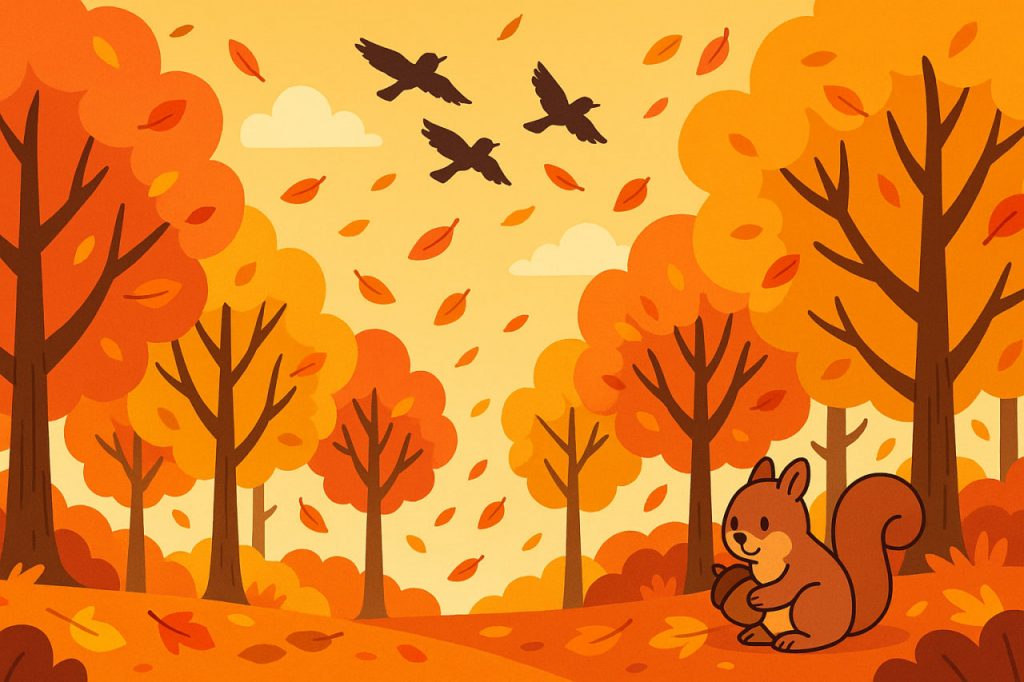Autumn, also known as fall, is one of the four main seasons of the year and is often considered the most colorful. It occurs between summer and winter, typically from September to November in the Northern Hemisphere and from March to May in the Southern Hemisphere. Autumn is not only a transition in climate but also a period rich in cultural traditions, natural beauty, and ecological importance.
Changes in Nature
One of the most distinctive features of autumn is the changing colors of leaves. As daylight decreases and temperatures drop, trees stop producing chlorophyll, the green pigment responsible for photosynthesis. This reveals other pigments such as carotenoids (yellow and orange) and anthocyanins (red and purple), creating a vivid natural palette. The falling of leaves also helps trees conserve water and energy during the colder months.
Weather Shifts
Autumn brings cooler temperatures, shorter days, and longer nights. The air often becomes crisper, and winds grow stronger, signaling the coming of winter. These changes influence animal behavior, plant cycles, and even human daily routines.
Animal Behavior
In autumn, many animals prepare for winter. Birds migrate to warmer regions, while other animals gather food or grow thicker fur. Some, like bears, begin to build fat reserves for hibernation. This season is therefore crucial for survival in ecosystems.
Cultural and Social Significance
Autumn has deep cultural meanings across the world. It is often linked with harvest festivals, as many crops are gathered during this season. Thanksgiving in North America, Mid-Autumn Festival in Asia, and various European harvest traditions highlight its importance in human life. It is also a time of reflection, with many cultures seeing autumn as symbolic of maturity and preparation for rest.
Health and Lifestyle
The cooler temperatures encourage outdoor activities such as hiking and enjoying seasonal foods like pumpkins, apples, and nuts. However, the reduction of daylight can also affect mood and energy levels, leading to phenomena such as seasonal affective disorder (SAD). Spending time outdoors can help balance these effects.
Conclusion
Autumn is special because it blends natural transformation, ecological preparation, and cultural celebration. With its vibrant landscapes, symbolic harvests, and profound influence on life cycles, autumn stands out as a season of both beauty and change.
Interesting Facts
Autumn, also known as fall, is one of the most dynamic and scientifically fascinating seasons of the year. It marks the period when Earth’s axis tilt causes sunlight to hit the Northern and Southern Hemispheres at a lower angle, bringing cooler temperatures and shorter days. The stunning colors of fall foliage result from the breakdown of chlorophyll, revealing pigments like carotenoids (yellow and orange) and anthocyanins (red and purple). Interestingly, the intensity of these colors depends on temperature, sunlight, and moisture levels — cool, sunny days followed by chilly nights produce the brightest leaves. Autumn is also a critical time for animal migration and hibernation preparation, as species store energy for the coming winter. In human culture, fall has long symbolized harvest, reflection, and transition, celebrated in festivals across the world. Scientifically and emotionally, it represents the perfect blend of balance between light and darkness, activity and rest.
Glossary
- Chlorophyll – green pigment in plants used for photosynthesis.
- Carotenoids – pigments that produce yellow and orange colors in leaves.
- Anthocyanins – pigments responsible for red and purple hues in plants.
- Migration – seasonal movement of animals from one region to another.
- Seasonal Affective Disorder (SAD) – mood changes linked to reduced daylight.


